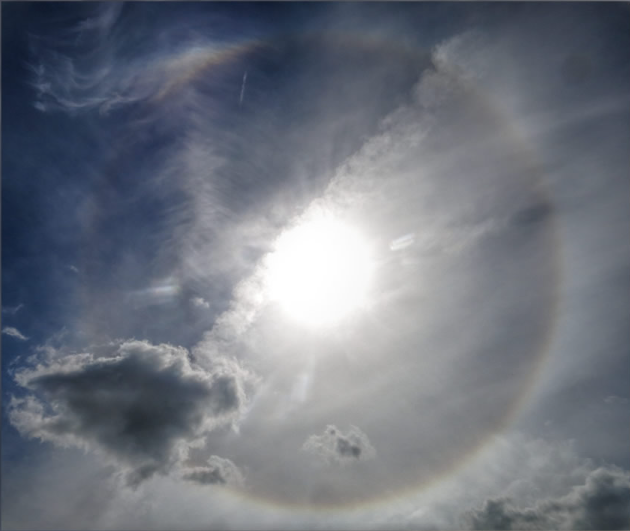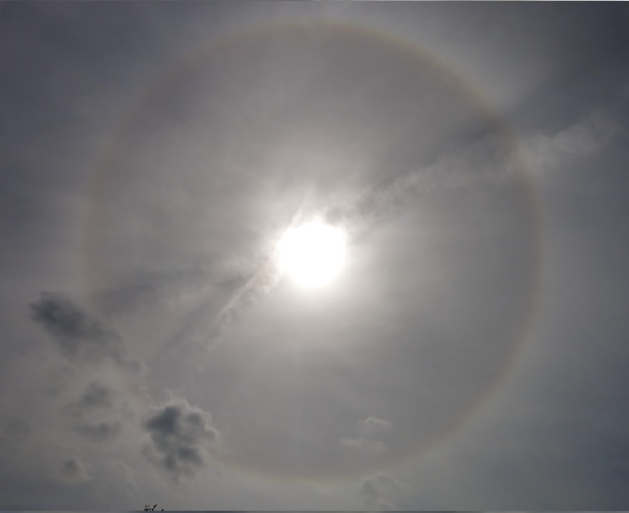Long lived 22 degree halo, Cheshire, England - OPOD
Long Lived 22 Degree Halo: A Spectacular Atmospheric Optics Phenomenon in Cheshire, England
The skies of Cheshire, England were adorned with a mesmerizing display of atmospheric optics on May 1, '15. Emma Taylor, an avid photographer, captured the beauty of a long-lived 22 degree halo that graced the heavens for nearly three hours. These captivating images allow us to witness the transformation of delicate colors in cirrus wisps to the more subdued and 'solid' halo that emerged as the cirrostratus clouds thickened.
A Halo That Stands the Test of Time
The endurance of this particular halo is truly remarkable. While halos are not uncommon phenomena, they typically appear for shorter durations. However, this long-lived 22 degree halo defied expectations and captivated onlookers for an extended period. The prolonged display provided ample opportunity to observe the subtle changes in its appearance as the surrounding atmospheric conditions evolved.
Exploring the Halo's Evolution
As the cirrus clouds thickened, the colors of the halo became more subdued, transforming from delicate hues to a solid and distinct ring. This transition allowed observers to witness the interplay between light and atmospheric particles, offering a deeper understanding of the optical processes at work.
A Lens Effect and Its Illusory Streaks
In some of the images, short radial streaks can be seen emanating from the sun. These streaks are a result of a lens effect and can be disregarded when analyzing the halo itself. By recognizing and disregarding these illusory streaks, we can focus our attention on the true beauty and intricacies of the halo phenomenon.
The Intriguing Role of Contrails
One particularly captivating moment captured by Emma Taylor's photographs is when a contrail intersects with the sun, casting a shadow downward onto the lower halo-forming cirrus layer. This interaction adds an additional layer of complexity and visual interest to the scene, showcasing the dynamic nature of atmospheric optics.
A Continent of Halos
The long-lived 22 degree halo over Cheshire, England was not an isolated occurrence. In fact, Europe had experienced numerous halo sightings in the days leading up to this event. This cluster of halos across the continent demonstrates the sporadic and unpredictable nature of atmospheric phenomena, further adding to their allure and fascination.
Capturing the Beauty Through Photography
Emma Taylor's photographs not only document the stunning visuals of the long-lived 22 degree halo but also serve as a testament to the power of photography in capturing and sharing the wonders of our natural world. Through her lens, we are able to witness the ethereal beauty of atmospheric optics and appreciate the delicate interplay between light, clouds, and particles.
A Reminder of Nature's Marvels
The long-lived 22 degree halo over Cheshire, England serves as a reminder of the awe-inspiring wonders that can be found in our own skies. These captivating atmospheric optics phenomena offer a glimpse into the intricate mechanisms at work in our atmosphere and ignite a sense of wonder and curiosity within us.
Reflecting on the Past
Please note that this article has been automatically converted from the old site and may not appear as intended. However, the original article can be accessed here for those interested in exploring further.
In conclusion, the long-lived 22 degree halo observed over Cheshire, England was a truly remarkable display of atmospheric optics. Its endurance and captivating transformation provided a unique opportunity for observers to witness the subtle changes in its appearance. As we marvel at these natural phenomena, we are reminded of the boundless beauty and complexity of our atmosphere, continually inviting us to explore and appreciate the wonders that surround us.

Long Lived Halo
Emma Taylor (Emma Taylor's Photographs) saw this 22 degree halo over Cheshire, England on May 1, '15.
The halo lasted almost three hours and the images capture the changes from delicate colours in cirrus wisps to the more subdued and 'solid' halo we see in thicker cirrostratus.
Europe has had many halos (1,2) over the past few days - may it continue!
All images ©Emma Taylor, shown with permission

The short radial streaks from the sun are a lens effect. ignore them.

The cirrus has thickened and the halo's colours are more subdued.
A contrail crosses the sun and casts a shadow downwards onto the lower halo forming cirrus layer.
Note: this article has been automatically converted from the old site and may not appear as intended. You can find the original article here.
Reference Atmospheric Optics
If you use any of the definitions, information, or data presented on Atmospheric Optics, please copy the link or reference below to properly credit us as the reference source. Thank you!
-
<a href="https://atoptics.co.uk/blog/long-lived-22-degree-halo-cheshire-england-opod/">Long lived 22 degree halo, Cheshire, England - OPOD</a>
-
"Long lived 22 degree halo, Cheshire, England - OPOD". Atmospheric Optics. Accessed on November 26, 2024. https://atoptics.co.uk/blog/long-lived-22-degree-halo-cheshire-england-opod/.
-
"Long lived 22 degree halo, Cheshire, England - OPOD". Atmospheric Optics, https://atoptics.co.uk/blog/long-lived-22-degree-halo-cheshire-england-opod/. Accessed 26 November, 2024
-
Long lived 22 degree halo, Cheshire, England - OPOD. Atmospheric Optics. Retrieved from https://atoptics.co.uk/blog/long-lived-22-degree-halo-cheshire-england-opod/.